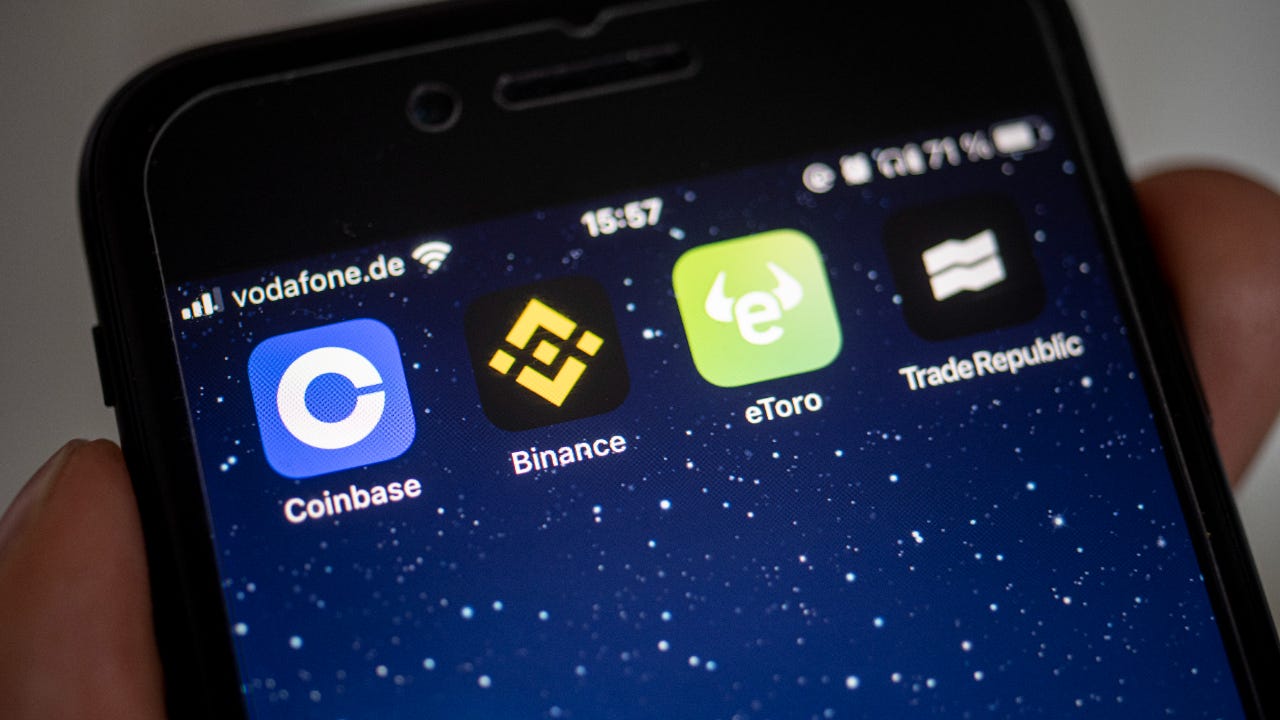Binance vs. Coinbase: Which crypto exchange is right for you?

Binance.US and Coinbase are two of the most popular cryptocurrency exchanges around, so which should you choose? The answer depends on what exactly you need, which crypto coins you want to trade, how much you’re willing to pay for commissions and other key factors.
Coinbase and Binance.US are both major players among established cryptocurrency exchanges. In this article we’ll refer to Binance.US – the American arm of the larger Binance organization – as Binance. We’ll compare it to Coinbase Advanced Trade, which offers much lower costs than the basic Coinbase service, though we’ll refer to it as Coinbase.
In June 2023, the Securities and Exchange Commission sued Binance and Coinbase, alleging they illegally operated as exchanges, broker-dealers and clearing agencies, as well as offered and sold unregistered securities. Binance was also accused of misusing customer funds and the SEC warned investors of using its platforms. Binance said its customers’ assets are safe and Coinbase said it would continue to operate its business as usual.
Here’s how Binance and Coinbase compare on some of the most important factors to traders.
Binance vs. Coinbase: Cost
The most significant cost you’re likely to pay are your trading fees, and if you’re doing a lot of it, those can certainly add up. Fortunately, it’s the norm for most exchanges to offer discounts based on your 30-day trading volume. However, Binance even goes one better than that.
Both Coinbase and Binance use a maker-taker pricing structure, charging based on whether you add liquidity to the market (makers) or remove liquidity from the market (takers). So trading fees generally differ not only on your volume but also the type of trade you make. However, Binance allows you to dodge the commissions on Bitcoin and Ethereum trades entirely.
Here’s how each exchange breaks down on its fees. Binance’s commission depends on which coin you’re trading: Bitcoin and Ethereum (Tier 0) or less popular coins (Tier 1).
Binance trading fees
The pricing structure below is for coins that are not Bitcoin and Ethereum.
| 30-day volume | Maker | Taker |
|---|---|---|
| Less than $10,000 | 0.40 percent | 0.60 percent |
| $10,000 – $50,000 | 0.25 percent | 0.40 percent |
| $50,000 – $100,000 | 0.15 percent | 0.25 percent |
| $100,000 – $1 million | 0.10 percent | 0.20 percent |
| $1 million – $20 million | 0.08 percent | 0.18 percent |
| $20 million – $100 million | 0.05 percent | 0.15 percent |
| $100 million – $300 million | 0.02 percent | 0.10 percent |
| $300 million – $500 million | 0 percent | 0.08 percent |
| $500 million and up | 0 percent | 0.05 percent |
Coinbase Advanced Trade trading fees
| 30-day volume | Maker | Taker |
|---|---|---|
| Less than $10,000 | 0.40 percent | 0.60 percent |
| $10,000 – $50,000 | 0.25 percent | 0.40 percent |
| $50,000 – $100,000 | 0.15 percent | 0.25 percent |
| $100,000 – $1 million | 0.10 percent | 0.20 percent |
| $1 million – $15 million | 0.08 percent | 0.18 percent |
| $15 million – $75 million | 0.06 percent | 0.16 percent |
| $75 million – $250 million | 0.03 percent | 0.12 percent |
| $250 million – $400 million | 0 percent | 0.08 percent |
| $400 million and up | 0 percent | 0.05 percent |
The results are neck and neck: For coins that aren’t Bitcoin or Ethereum, Binance and Coinbase have headline commissions that are nearly the same amount, with the exception of a few “pockets” in the pricing structure. For 30-day volume up to $15 million, you’re paying the same headline rate. But there’s a wrinkle: Binance will cut your fees a further 25 percent if you use BNB, its own in-house coin, to pay for trading fees.
For example, imagine you’ve placed $25,000 in trades in the prior 30 days and you want to place another $10,000 trade. At Coinbase you’d pay 0.25 or 0.40 percent as a maker or taker, respectively, for a total cost of $25 or $40. In comparison, you’d pay the same amount at Binance for that trade, unless you paid with BNB, cutting the fees to $18.75 and $30, respectively.
Advantage: Binance offers a clear advantage on what’s likely to be the largest group of ongoing fees you’ll pay. In addition to this little extra discount, Binance allows you to trade the two biggest-volume coins for free: Bitcoin and Ethereum. Given their predominance for traders, it seems like Binance would be the clear choice.
Binance vs. Coinbase: Supported cryptocurrencies
The straight numbers look to be in Coinbase’s favor in terms of how many total kinds of coins are offered by each exchange. At our last count, Coinbase gives traders access to 253 coins, while Binance offers access to 153, or about 60 percent as many as its rival.
But all that choice is like a buffet: If you don’t want to trade a specific coin, it doesn’t matter if it’s there or not. So how do these exchanges compare on the top 12 coins by market capitalization? A comparison there might tease out some differences. On that basis, Binance is slightly better, offering all 12 the top coins, compared to Coinbase’s 10. Both offer Bitcoin, of course, and the difference is that Binance offers BNB, the coin powering Binance’s own ecosystem, and XRP.
Advantage: Coinbase gets the edge here.
Binance vs. Coinbase: Staking rewards
Over the last year, Binance has made real improvements on the number of coins available in its staking rewards programs, really outdistanced its rival Coinbase.
Staking rewards provide crypto owners a chance to receive income for supporting the token as part of the verification process. Typically, an exchange simply deposits your income, net of any fees, into your account. Coinbase and Binance take a commission on your rewards.
Coinbase allows staking on six coins, including Ethereum, one of the largest coins, as well as Solana and Cardano. It also allows other rewards, via DeFi (not available in the U.S.), on a handful of other coins, as well as what it calls “cloud staking” on more than 15 coins. Cloud staking is a somewhat different and more advanced process, however.
Binance supports staking on 27 coins, including Ethereum, Cardano and Solana.
As for how large those staking rewards are? A spot check shows Binance offering consistently higher rewards on the handful of coins that they have in common.
Advantage: Binance beats out Coinbase on the number of coins supported in the core staking rewards program, and offers higher rewards on those that they have in common. Naturally, for those who hold coins supported on one platform but not the other, a specific exchange may end up being better for them.
Binance vs. Coinbase: Deposit and withdrawal fees
Neither Coinbase nor Binance charges deposit or withdrawal fees for ACH deposits in U.S. dollars. On wire transfers, Binance does a bit better, with no charge for wire deposits and a $15 withdrawal fee for domestic wires. For its part, Coinbase charges $10 for wire deposits into its accounts and $25 for wire withdrawals.
Advantage: Binance offers a better fee structure here, both for ACH fees and even wire fees. However, if you plan to use wires frequently, Binance would be the clearly better outfit.
Binance vs. Coinbase: Customer support
Customer support at crypto exchanges seems to be mostly an afterthought, though it has improved over the last year. Coinbase has grown its efforts here recently, adding 24/7 phone and chat support, much-needed features to prior options that included only email and a support ticket. Plus, if you see suspicious activity, you can call customer support to lock your account (though it raises the question of why this feature is needed, when traditional stock brokers seem to have no such issues.)
Binance offers support tickets and recently added 24/7 online chat, which perhaps is part of the price you pay for its very low trading costs.
Advantage: With a variety of support options, Coinbase looks like the clear winner here.
Bottom line
On what’s probably the single most important feature of an exchange – cost – Binance gets the win. Low trading costs played into Binance being named the best crypto exchange by Bankrate.
However, on the finer details, such as available coins, Coinbase wins outright or has a small advantage. In a comparison of Coinbase to Binance then, the true winner may be the exchange that fits your needs best — whether that’s low trading fees, widest selection or better support.






